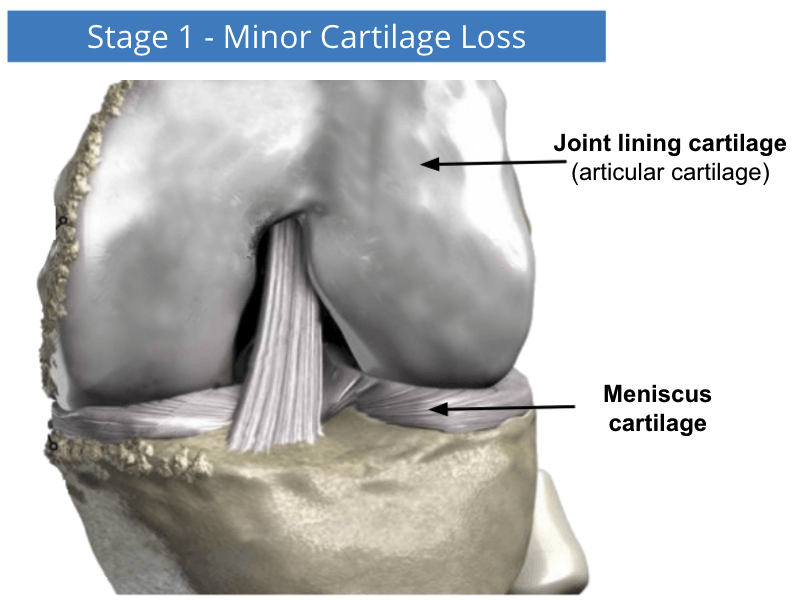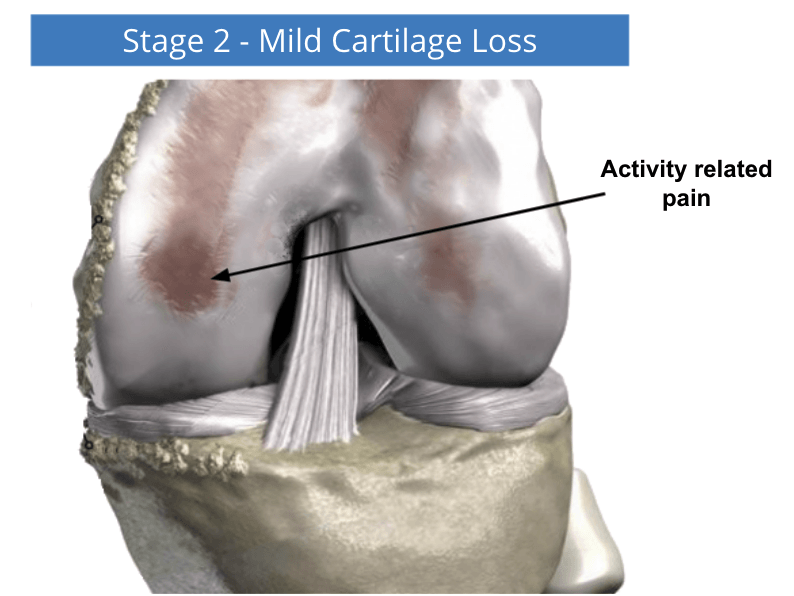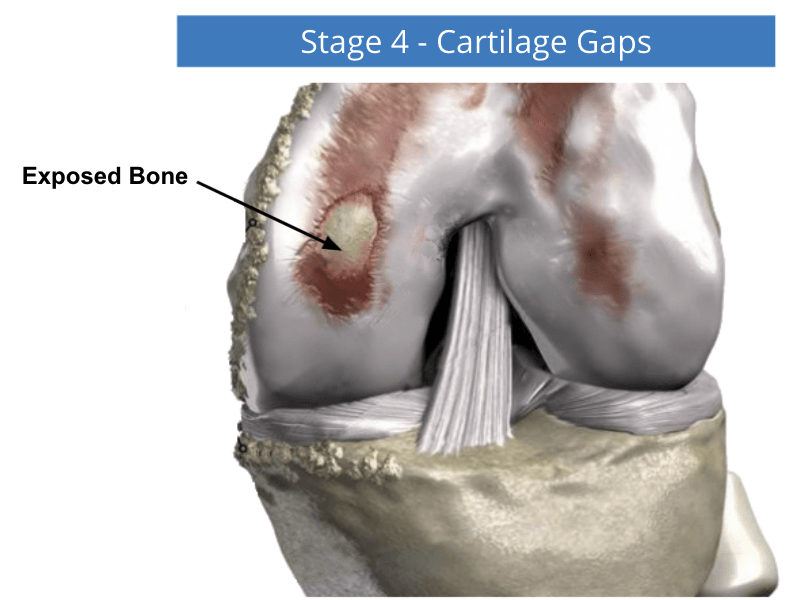Knee Arthritis
What is Arthritis of the Knee?
Arthritis, also known as osteoarthritis, is a general term covering more than 100 conditions where the joint surface (cartilage) wears out.
The joint surface of the knee is covered by a smooth articular surface that allows pain free movement in the joint.
When this articular cartilage wears out, the bone ends rub on one another and cause pain. There are many conditions that can cause arthritis and often the exact cause is never known.
In general, but not always it affects people as they get older (Osteoarthritis).
The term arthritis literally means inflammation of a joint, but is generally used to describe any condition in which there is damage to the cartilage. Inflammation is the body's natural response to injury.
Stages of Knee Arthritis
The cartilage is a padding that absorbs stress.
The proportion of cartilage damage and synovial inflammation varies with the type and stage of arthritis. Usually the pain early on is due to inflammation.
In the later stages, when the cartilage is worn away, most of the pain comes from the mechanical friction of raw bones rubbing on each other.
What are the different types of arthritis?
There are over 100 different types of arthritis. The most common are:
Osteoarthritis
Also called degenerative joint disease, this is the most common type of arthritis, which occurs most often in older people.
This disease affects cartilage, the tissue that cushions and protects the ends of bones in a joint. With osteoarthritis, the cartilage starts to wear away over time. In extreme cases, the cartilage can completely wear away, leaving nothing to protect the bones in a joint, causing bone-on-bone contact. Bones may also bulge, or stick out at the end of a joint, called a bone spur.
Osteoarthritis causes joint pain and can limit a person's normal range of motion (the ability to freely move and bend a joint). When severe, the joint may lose all movement, causing a person to become disabled.
Disability most often happens when the disease affects the spine, knees, and hips.
Ankylosing Spondylitis
This disease most often affects the spine, causing pain and stiffness. It can also cause arthritis in the knees. It affects mostly men in their late teenage and early adult years.
Polymyalgia Rheumatica
Because this disease involves tendons, muscles, ligaments, and tissues around the joint, symptoms often include pain, aching, and morning stiffness in the shoulders, hips, neck, and lower back. It is sometimes the first sign of giant cell arteritis, a disease of the arteries characterised by inflammation, weakness, weight loss, and fever.
Bursitis
This condition involves inflammation of the bursa, small, fluid-filled sacs that help reduce friction between bones and other moving structures in the joints. The inflammation may result from arthritis in the joint or injury or infection of the bursa. Bursitis produces pain and tenderness and may limit the movement of nearby joints.
Tendinitis
Also called tendonitis, this condition refers to inflammation of tendons (tough cords of tissue that connect muscle to bone) caused by overuse, injury, or a rheumatic condition. Tendinitis produces pain and tenderness and may restrict movement of nearby joints.
What Causes Osteoarthritis?
Osteoarthritis is caused by the wearing out of the cartilage covering the bone ends in a joint. This may be due to excessive strain over prolonged periods of time, or due to other joint diseases, injury or deformity.
Primary osteoarthritis
is commonly associated with ageing and general degeneration of joints.
Secondary osteoarthritis
is generally the consequence of another disease or condition, such as repeated trauma or surgery to the affected joint, or abnormal joint structures from birth.
Uric acid crystal build-up is the cause of gout and long-term crystal build-up in the joints may cause deformity.
Predisposing Factors To Osteoarthritis Of Knee
Abnormalities of knee joint function resulting from fractures of the knee, torn cartilage and torn ligaments can lead to degeneration many years after the injury. The mechanical abnormality leads to excessive wear and tear - just like the out-of-balance tyre that wears out too soon on your car. Obesity has been shown to accelerate arthritis.
What Are The Symptoms Of Arthritis?
The warning signs of Arthritis are related to inflammation in one or more joints for more than two weeks. Typical symptoms are:
- redness
- tenderness
- swelling,
- heat and
- pain.
- limitation of motion of a joint,
- early morning stiffness
- skin changes including rashes.
How is Arthritis Diagnosed?
Doctors diagnose arthritis with a medical history, physical exam and X-rays of the knee. There is no blood test for osteoarthritis.
What You Can Do?
Consult a doctor who will determine the type of arthritis you have
- Rest the joint until the pain subsides to prevent further inflammation
- To ease the pain or stiffness of the joint, apply heat on the joint for about 15 minutes once or twice a day using a hot water bottle, towel or an infrared lamp
- Take painkillers or anti-inflammatories, as recommended by your doctor
- If you are overweight, try to reduce weight to lighten the load on weight-bearing joints
- Participate in regular exercise
What Your Doctor Can Do For You?
There is no cure for arthritis, so beware of 'miracle cures'. Your doctor may prescribe anti-inflammatory medicine. They may recommend occupational therapy or physiotherapy, which includes exercises and heat treatment.
In severe cases, surgery may be suggested, such as a knee replacement. The type of surgery will depend on your age and severity of the disease. In the elderly with severe arthritis, joint replacement can give good results.
Treatment Options
Initial treatment for osteoarthritis of the knee is conservative, consisting of rest, avoidance of vigorous weight bearing activities, and the use of non-narcotic analgesic and or anti inflammatory medications. With worsening symptoms a cane or a knee brace may be helpful
For more severe symptoms, an injection of cortisone into the joint is frequently advised and can be quite helpful.
Treatment of osteoarthritis focuses on decreasing pain and improving joint movement, and may include:
- Exercises to keep joints flexible and improve muscle strength
- Many different medications are used to control pain, including corticosteroids and NSAIDs
- Glucocorticoids injected into joints that are inflamed and not responsive to NSAIDS
- For mild pain without inflammation, acetaminophen may be used
- Heat/cold therapy for temporary pain relief
- Joint protection to prevent strain or stress on painful joints
- Surgery (sometimes) to relieve chronic pain in damaged joints
- Weight control to prevent extra stress on weight-bearing joints
When conservative measures have been exhausted and are no longer helpful, and the arthritis has become disabling, surgery may be recommended.
Surgery for Arthritis
When conservative measures have been exhausted, offer no relief, and have become disabling, surgery may be recommended. Surgery is usually considered if non-surgical treatment fails to give relief.
There are different surgical procedures that can be used and may include:
Arthroplasty
In this procedure, your surgeon removes the affected joint and replaces it with an artificial implant. It is usually performed when the joint is severely damaged by osteoarthritis, rheumatoid arthritis, post-traumatic arthritis or avascular necrosis.
The goal of the surgery is to relieve pain and restore the normal functioning of the joint. Total joint replacement can be performed through an open or minimally invasive approach.
Your surgeon will discuss these options and help you decide which type of surgery is the most appropriate for you.
Does Exercise Really Help Those Who Have Arthritis?
Exercise is very important because it increases lubrication of the joints and strengthens the surrounding muscles, putting less stress on joints.
Exercise in heated swimming pools-hydrotherapy-can bring enormous relief from pain and stiffness.
Also studies have shown that exercise helps people with arthritis by reducing joint pain and stiffness and increasing flexibility, muscle strength and energy. It also helps with weight reduction and offers an improved sense of well-being.









